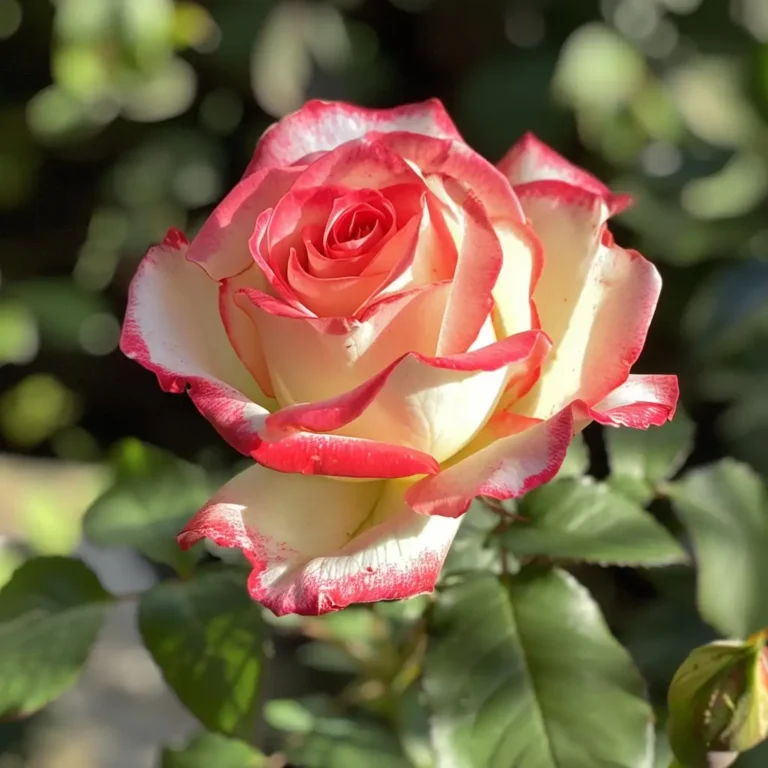Introduction
Rosa ‘Double Delight’ is one of the most beloved hybrid tea roses, known for its striking appearance and captivating fragrance. This article explores everything you need to know about this exceptional rose, from its history and characteristics to cultivation tips and real-life examples.
History and Origin
Rosa ‘Double Delight’ was developed in the United States in 1977 by Herbert Swim and A.E. “Bud” Jones. This hybrid tea rose quickly gained popularity due to its unique bi-color petals and intense fragrance.
Key Breeders and Timeline:
- Developed by Herbert Swim and A.E. “Bud” Jones
- Introduced to the market in 1977
Description and Characteristics
Rosa ‘Double Delight’ is renowned for its striking bi-color petals, which start as creamy white and develop vibrant red edges as they mature. The blooms are large, averaging 4-6 inches in diameter, and have a strong, spicy fragrance that captivates any garden enthusiast.
Physical Appearance:
- Bi-color petals: creamy white with red edges
- Bloom size: 4-6 inches
- Fragrance: strong and spicy
Growth Habits and Flowering Cycle:
- Repeat bloomer
- Medium-sized shrub, typically 3-4 feet tall
Cultivation and Care
Cultivating Rosa ‘Double Delight’ requires attention to several key factors to ensure healthy growth and abundant blooms.
Soil Requirements:
- Well-drained, fertile soil
- pH range: 6.0-6.5
Planting Techniques:
- Plant in a sunny location with at least 6 hours of direct sunlight
- Space plants 2-3 feet apart to ensure good air circulation
Watering Needs:
- Regular watering, especially during dry spells
- Avoid overhead watering to prevent fungal diseases
Pruning and Maintenance:
- Prune in early spring to remove dead or weak stems
- Regular deadheading to encourage continuous blooming
Pest and Disease Management:
- Monitor for common pests like aphids and spider mites
- Treat with appropriate insecticides or organic solutions
Environmental Adaptability
Rosa ‘Double Delight’ thrives in various environments but performs best in temperate climates.
Climate Preferences:
- Prefers mild climates with moderate humidity
- Can tolerate temperatures down to -10°F
Hardiness Zones:
- USDA zones 5-9
Adaptability:
- Suitable for both garden beds and containers
- Requires winter protection in colder regions
Uses and Applications
Rosa ‘Double Delight’ is a versatile rose with several applications:
- Landscaping: Adds visual interest with its bi-color blooms and pleasant fragrance
- Cut Flower Arrangements: Long stems and large blooms make it a favorite for bouquets
- Aromatherapy: The strong scent can be used in homemade potpourri or essential oils
Popular Varieties and Comparisons
While Rosa ‘Double Delight’ is unique, several other hybrid tea roses offer similar beauty and fragrance.
Comparison with Other Hybrid Tea Roses:
- ‘Peace’: Known for its pastel blooms and mild fragrance
- ‘Mr. Lincoln’: Deep red blooms with a strong fragrance
Unique Features:
- Bi-color petals
- Strong, spicy fragrance
Popular Companion Plants:
- Lavender: Enhances the rose’s fragrance and deters pests
- Salvia: Adds contrasting color and attracts beneficial insects
Growing Tips and Best Practices
Growing Rosa ‘Double Delight’ successfully requires adhering to some best practices.
Tips for Beginners:
- Start with healthy, disease-free plants from reputable nurseries
- Mulch around the base to retain moisture and suppress weeds
Advanced Cultivation Techniques:
- Practice grafting to improve disease resistance
- Use organic fertilizers to promote healthy growth
Common Mistakes:
- Overwatering, which can lead to root rot
- Neglecting to prune, resulting in poor air circulation and increased disease risk
Case Studies and Real-Life Examples
Many gardeners have successfully cultivated Rosa ‘Double Delight’ with stunning results.
Successful Cultivation Stories:
- A gardener in California reports vibrant blooms and robust growth with minimal pest issues.
- In the UK, a rose enthusiast successfully grows ‘Double Delight’ in containers, enjoying blooms from late spring to fall.
Notable Gardens Featuring ‘Double Delight’:
- The Rose Garden at the Huntington Library in California
- The David Austin Rose Gardens in Shropshire, England
Frequently Asked Questions
What makes Rosa ‘Double Delight’ special?
Rosa ‘Double Delight’ stands out due to its unique bi-color petals and strong, spicy fragrance.
How to care for Rosa ‘Double Delight’?
Ensure well-drained soil, regular watering, and proper pruning. Monitor for pests and treat as necessary.
What are the ideal growing conditions for ‘Double Delight’?
Plant in a sunny location with fertile, well-drained soil. Suitable for USDA zones 5-9.
How often does ‘Double Delight’ bloom?
‘Double Delight’ is a repeat bloomer, providing multiple flushes of blooms throughout the growing season.
Can ‘Double Delight’ be grown in containers?
Yes, ‘Double Delight’ can be successfully grown in containers with proper care and regular watering.
Conclusion
Rosa ‘Double Delight’ is a remarkable hybrid tea rose that offers beauty, fragrance, and versatility. Whether you’re an experienced gardener or a beginner, this rose can enhance any garden or home with its stunning blooms and delightful scent. By following the cultivation tips and best practices outlined in this guide, you can enjoy the beauty and fragrance of Rosa ‘Double Delight’ for many seasons to come.

